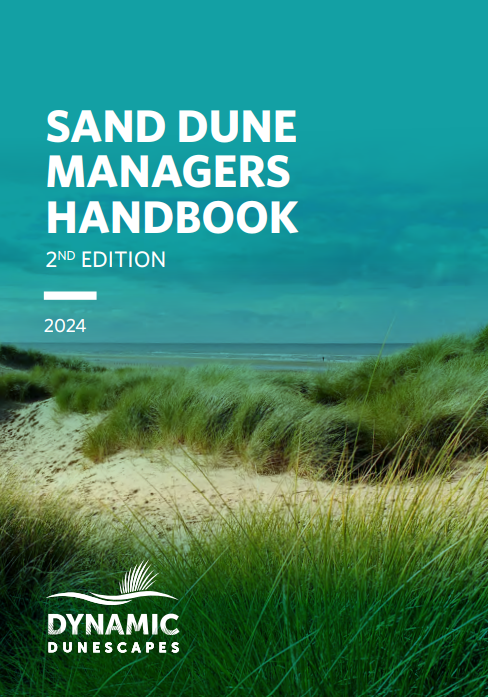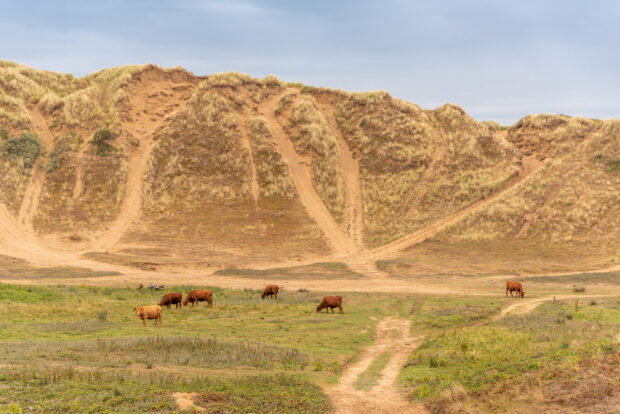
Natural England are delighted to announce the launch of the much anticipated second edition of the Dynamic Dunescapes Sand Dune Manager’s Handbook. This update has been written to support site managers and landowners to improve the condition of sand dunes across the UK and protect the rare and often unique species that have adapted to live in sand.
The updated edition draws upon the learnings from the Dynamic Dunescapes project by including 35 instructive case studies written by dedicated local site managers and others directly involved with the project. The case studies capture the project’s experiences of using novel and adaptive management approaches and shares best practise to benefit others involved in dune management.
Dynamic Dunescapes is a partnership project restoring sand dunes across England and Wales for the benefit of wildlife, people and communities. It has delivered conservation work at scale and undertaken engagement work that has both supported the conservation work as well as made a wider contribution to tackling inequalities. Project partners are Natural England, Plantlife, National Trust, Natural Resources Wales, Cornwall Wildlife Trust, Lincolnshire Wildlife Trust and Cumbria Wildlife Trust. The project budget of £10 million includes funding from two major funders, The National Lottery Heritage Fund and the EU LIFE Programme, alongside partner and in-kind contributions.

In the UK it is estimated that there are 71,569ha of sand dunes (which is about twice the area of the Isle of Wight) - but it is thought that the UK has lost 30% of its dune habitat since 1900. Coastal dune systems are still under threat from pressures such as over-stabilisation, development and climate change, and require management and restoration to reverse this decline.
The approach to dune management has changed over the decades as ecologists have carried out research and learnt more. There is now recognition that in order for dunes to be healthy, self-sustaining, and biodiverse they must be dynamic, and management is now aimed at supporting these natural processes and encouraging mobility of sand in the dunes. However, occasionally dune stabilisation may still be relevant in some locations.
Naturally functioning, dynamic sand dune systems are among the most natural remaining habitat types in the UK. Dunes are wild, iconic landscapes that are universally recognisable. They are unique habitats that support more than 70 nationally rare or red-data book species and are a refuge for many lowland species lost elsewhere. They are also important to our physical and psychological wellbeing, recreation, leisure and learning.
The new edition of the handbook is presented in an engaging and user-friendly format similar to that adopted by the highly successful series of coastal and marine habitat restoration publications available through The Catchment Based Approach (CaBA).
It offers a UK-wide perspective to include and recognise the contributions from other major dune projects such as Sands of LIFE in Wales and Gems in the Dunes, part of the Back from the Brink project. The new edition handbook also recognises regional variations in habitat type including a new section on machair – a rare type of habitat unique to the exposed northwest coasts of Scotland and Ireland that is renowned for its abundant diversity of flora and fauna.

The second edition also attempts to capture the influence of wider land uses including military training, golf courses and forestry across dune systems around the UK. Acknowledging the challenges this can present to dune habitat restoration whilst identifying the opportunities for partnership working and collaborative management approaches.
The Dynamic Dunescapes project has been instrumental in communicating with local communities and visitors and the handbook highlights some of the messaging around dynamic dunes and advice on disseminating key messages effectively.
The handbook shares insights on how effective engagement through communications and campaigns, e.g. Paws for Thought and Arty Cows, can be used to target specific issues or raise awareness of activity. Forging a connection between arts, the dunes, and local people can help facilitate conversations within and about the landscape.
What’s included:
The handbook begins with a background to dune ecology, geomorphology and hydrology, with information on why dunes are important and why they should be conserved. It also provides advice on starting a dune restoration project, looking at project planning phases, funding streams and permissions.
Through a range of case studies, this version of the handbook looks at restoration and management techniques and explores specific land uses that influence dune management. It also provides information on some characteristic dune species, such as Natterjack Toad, Sand Lizard and Petalwort.
Finally, monitoring requirements and advice on public engagement and communication have also been updated.
The Sand Dune Manager’s Handbook second edition has been compiled in collaboration by leading experts from across statutory agencies, academics, NGOs and practitioners, all specialists in their field and brings together the latest knowledge and expertise in sand dune management. The aim is that this knowledge will be used to improve the condition of sand dune habitats nationwide through science and evidence led best practice.
You can download the handbook for free below.
Find out more about the Dynamic Dunescapes Project here